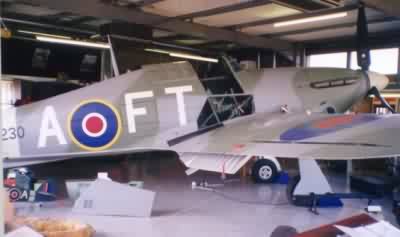| The Structure The wings are divided
into three main components, the centre section and the two outer wings.
The centre section consists primarily of two continuous spars, the polygonal
rolled-steel booms and steel plate webs, connected by ribs and drag bracing.
It houses the retractable undercarriage and main fuel tanks. The outer
wings of the prototype and early production Hurricanes were built up on
two main spars similar in construction to the centre-section spars, and
braced torsionally by a system of strong diagonal members between the spars.
The wings were fabric covered over a framework of light metal ribs. . In
1938 a completely new stressed-skin outer wing was designed. It was introduced
on the production Hurricanes in 1939. The new outer wings are built up
on two main spars of extruded s-section booms with double webs at the inboard
end which are reduced to T-sections with single webs towards the tip. A
diagonal bracing system in the gun bay was found to be convenient. The
diagonals are now made of T-section extrusions with plate webs. Immediately
outboard of the gun bay the wing is of the fully-stressed-skin type and
has two light auxiliary spars as well as the two main spars. The whole
wing is covered with a stressed skin of light alloy, 20gauge thick on the
top surface and 22 gauge on the bottom. The ribs are pressed from sheet.
The loads are diffused from the diagonally braced gun bay to the stressed-skin
portion through a torsionally stiff box rib made up of two heavy gauge
plate ribs with extruded T section booms immediately outboard of the gun
bay. There is an extra covering of 16 gauge light alloy as a reinforcement
underneath the normal skin covering. The ailerons, which have a metal framework
and fabric-covering, are built up on a tubular steel spar. They are the
same as on the earlier wings. The fuselage is built up on a basic rectangular
structure of steel and light alloy tubes with squared ends. The tubes are
connected by the standard Hawker method of flat plate fittings secured
by tubular rivets or bolts. The whole is rigidly braced. This basic structure
is faired to an oval section covered with detachable metal panels forward,
and aft with fabric over light wooden formers and stringers. The whole
of the cantilever tail unit has a metal frame and fabric covering. The
fin is built integral with the rear fuselage. The rudder is mass balanced.
The tailplane is of the fixed type. The aerodynamically balanced elevators
have trimming tabs. The retractable undercarriage has two semi-cantilever
Vickers shuck-absorber struts hinged at the outboard ends of the centre
section front spar, and retracted inwards by a Hawker mechanism actuated
by Dowty hydraulic rams, which brings the wheels up between the centre
section spars in the retracted position. A slight backward motion is provided
by a hinged rear strut which slides on a guide at right angles to the spar
of the wing. Emergency extension is by gravity. Dunlop wheels and pneumatic
brakes are fitted as standard. The Dowty tail wheel unit is not retractable.
Power Plant The standard 1,030 h.p. Rolls-Royce Merlin III is mounted on
a tubular structure similar in construction to the main fuselage. The motor
drives a Rotol three-blade constant-speed airscrew of 11 ft. diameter.
The Rotol is now standard on the Hurricane, the De Havilland airscrew on
the Spitfire. Some Hurricanes have de Havilland airscrews and can be recognised
by the more pointed spinner as compared with the rounded spinner of the
Rotol. These Rotol airscrews have wooden blades as standard. The fuel is
carried in two main tanks in the centre section between the spars with
a total capacity of 69 gallons. A further 28 gallons is carried in the
reserve tank in the fuselage in front of the pilot. The oil tank, with
an effective capacity of 7 + gallons, is in the port leading edge of the
centre section. The eight Browning machine-guns mounted in the wings, fire
at a total rate of 9,600 rounds per minute. Complete night flying equipment,
with landing lights in the wing leading edge, navigation lights, oxygen,
radio, flare tube, etc., is fitted as standard equipment. The main glycol
radiator is housed in a duct under the fuselage below the cockpit. The
oil cooler is sandwiched between the two elements of the glycol radiator.
The enclosed cockpit has a sliding canopy, immediately over the centre
section to give the pilot a good forward view. A bullet - proof windscreen
and armour protection for the pilot are provided. The seat is adjustable
for height, and the rudder bar for length of leg. With full tanks the Hurricane
has a range of 830 miles at 168 m.p.h. cruising at 5,000 ft. Cruising at
232 m.p.h. at 25,000 ft. the range is still 695 miles. |

